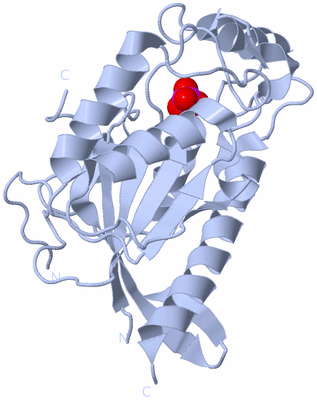| molecular function |
|---|
| | GO:0004083 | | bisphosphoglycerate 2-phosphatase activity | | Catalysis of the reaction: 2,3-bisphospho-D-glycerate + H(2)O = 3-phospho-D-glycerate + phosphate. |
| | GO:0003824 | | catalytic activity | | Catalysis of a biochemical reaction at physiological temperatures. In biologically catalyzed reactions, the reactants are known as substrates, and the catalysts are naturally occurring macromolecular substances known as enzymes. Enzymes possess specific binding sites for substrates, and are usually composed wholly or largely of protein, but RNA that has catalytic activity (ribozyme) is often also regarded as enzymatic. |
| | GO:0004331 | | fructose-2,6-bisphosphate 2-phosphatase activity | | Catalysis of the reaction: D-fructose 2,6-bisphosphate + H2O = D-fructose-6-phosphate + phosphate. |
| | GO:0016787 | | hydrolase activity | | Catalysis of the hydrolysis of various bonds, e.g. C-O, C-N, C-C, phosphoric anhydride bonds, etc. Hydrolase is the systematic name for any enzyme of EC class 3. |
| biological process |
|---|
| | GO:0006915 | | apoptotic process | | A programmed cell death process which begins when a cell receives an internal (e.g. DNA damage) or external signal (e.g. an extracellular death ligand), and proceeds through a series of biochemical events (signaling pathway phase) which trigger an execution phase. The execution phase is the last step of an apoptotic process, and is typically characterized by rounding-up of the cell, retraction of pseudopodes, reduction of cellular volume (pyknosis), chromatin condensation, nuclear fragmentation (karyorrhexis), plasma membrane blebbing and fragmentation of the cell into apoptotic bodies. When the execution phase is completed, the cell has died. |
| | GO:0006914 | | autophagy | | The process in which cells digest parts of their own cytoplasm; allows for both recycling of macromolecular constituents under conditions of cellular stress and remodeling the intracellular structure for cell differentiation. |
| | GO:0016311 | | dephosphorylation | | The process of removing one or more phosphoric (ester or anhydride) residues from a molecule. |
| | GO:0030388 | | fructose 1,6-bisphosphate metabolic process | | The chemical reactions and pathways involving fructose 1,6-bisphosphate, also known as FBP. The D enantiomer is a metabolic intermediate in glycolysis and gluconeogenesis. |
| | GO:0006003 | | fructose 2,6-bisphosphate metabolic process | | The chemical reactions and pathways involving fructose 2,6-bisphosphate. The D enantiomer is an important regulator of the glycolytic and gluconeogenic pathways. It inhibits fructose 1,6-bisphosphatase and activates phosphofructokinase. |
| | GO:0008152 | | metabolic process | | The chemical reactions and pathways, including anabolism and catabolism, by which living organisms transform chemical substances. Metabolic processes typically transform small molecules, but also include macromolecular processes such as DNA repair and replication, and protein synthesis and degradation. |
| cellular component |
|---|
| | GO:0005737 | | cytoplasm | | All of the contents of a cell excluding the plasma membrane and nucleus, but including other subcellular structures. |
| | GO:0005829 | | cytosol | | The part of the cytoplasm that does not contain organelles but which does contain other particulate matter, such as protein complexes. |
| | GO:0005741 | | mitochondrial outer membrane | | The outer, i.e. cytoplasm-facing, lipid bilayer of the mitochondrial envelope. |
| | GO:0005739 | | mitochondrion | | A semiautonomous, self replicating organelle that occurs in varying numbers, shapes, and sizes in the cytoplasm of virtually all eukaryotic cells. It is notably the site of tissue respiration. |
| | GO:0005634 | | nucleus | | A membrane-bounded organelle of eukaryotic cells in which chromosomes are housed and replicated. In most cells, the nucleus contains all of the cell's chromosomes except the organellar chromosomes, and is the site of RNA synthesis and processing. In some species, or in specialized cell types, RNA metabolism or DNA replication may be absent. |



 Description
Description
 Compounds
Compounds
 Chains, Units
Chains, Units
 Ligands, Modified Residues, Ions (1, 2)
Ligands, Modified Residues, Ions (1, 2)
 Sites (2, 2)
Sites (2, 2)
 SS Bonds (1, 1)
SS Bonds (1, 1)
 Cis Peptide Bonds (0, 0)
Cis Peptide Bonds (0, 0)
 SAPs(SNPs)/Variants (0, 0)
SAPs(SNPs)/Variants (0, 0)
 PROSITE Motifs (1, 2)
PROSITE Motifs (1, 2)
 Exons (0, 0)
Exons (0, 0)
 Sequences/Alignments
Sequences/Alignments
 SCOP Domains (0, 0)
SCOP Domains (0, 0)
 CATH Domains (0, 0)
CATH Domains (0, 0)
 Pfam Domains (0, 0)
Pfam Domains (0, 0)
 Gene Ontology (15, 15)
Gene Ontology (15, 15)
 Interactive Views
Interactive Views
 Still Images
Still Images
 Databases
Databases
 Analysis Tools
Analysis Tools
 Entries Sharing at Least One Protein Chain (UniProt ID)
Entries Sharing at Least One Protein Chain (UniProt ID)
 Related Entries Specified in the PDB File
Related Entries Specified in the PDB File

